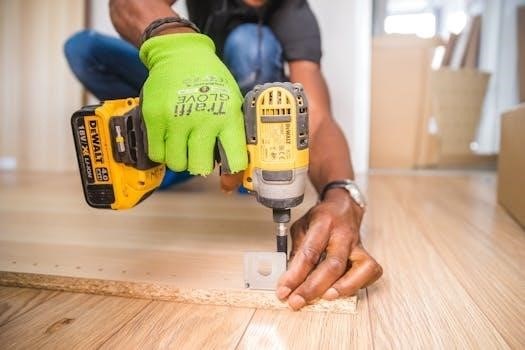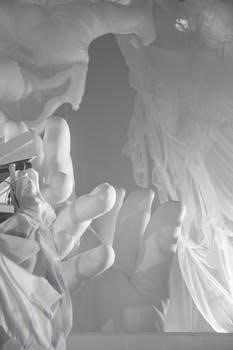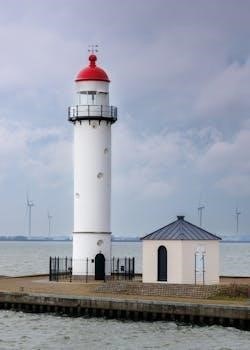Honeywell TH3210D1004 Installation Guide
This guide provides comprehensive instructions for installing the Honeywell TH3210D1004 thermostat, suitable for various heating and cooling systems. Follow these steps to ensure correct installation, wiring, and configuration of your device.
Product Overview⁚ TH3210D1004
The Honeywell TH3210D1004, part of the PRO 3000 series, is a non-programmable digital thermostat designed for residential use. This model is engineered to provide easy and precise temperature control for both heating and cooling systems. Its compatibility extends to conventional and heat pump systems, offering flexibility for different home setups.
Key features include a clear LCD display, simple operation, and reliable performance. The thermostat supports 2 Heat/1 Cool configurations for heat pump systems. Installation is straightforward, with detailed wiring instructions provided in the installation manual. The TH3210D1004 ensures comfortable home environments by maintaining consistent temperatures.
This thermostat offers a user-friendly interface for homeowners who prefer manual temperature adjustments. Its design is both functional and aesthetically pleasing, blending seamlessly with various interior styles. The Honeywell TH3210D1004 is a dependable choice for those seeking a simple, effective, and efficient thermostat solution.
Identifying the TH3210D1004 Model
To correctly identify the Honeywell TH3210D1004 model, look for the model number printed on the thermostat’s packaging or the device itself. Typically, it is located on the back of the thermostat or inside the battery compartment. The full model number, “TH3210D1004,” should be clearly visible.
The TH3210D1004 is part of the Honeywell PRO 3000 series, known for its non-programmable, digital thermostats. It supports 2 Heat/1 Cool configurations for heat pump systems. Visually, the thermostat features a rectangular design with a user-friendly LCD display. The exterior is typically premier white, fitting seamlessly into most home decors.
Confirming the model number ensures you have the correct installation guide and are following the appropriate wiring diagrams. This step is crucial for a successful installation and to avoid potential issues with your heating and cooling systems. Always double-check the model number before proceeding.
Key Features of the PRO 3000 Series
The Honeywell PRO 3000 series, including the TH3210D1004 model, is known for its simplicity and reliability. A key feature is its non-programmable design, making it easy to use without complex scheduling. It offers precise temperature control, ensuring consistent comfort in your home.
The TH3210D1004 supports 2 Heat/1 Cool configurations for heat pump systems, providing flexibility for different HVAC setups. Its large, clear LCD display shows the current temperature and setpoint, enhancing usability. The thermostat also includes an easy-access front-load battery compartment for convenient maintenance.
Designed for horizontal mounting, the PRO 3000 series features intuitive controls for switching between heating, cooling, and fan modes. Its durable construction and premier white finish ensure long-lasting performance and aesthetic appeal. These features combine to make the TH3210D1004 a reliable choice.

Pre-Installation Steps
Before installing the TH3210D1004, ensure safety by disconnecting power to the HVAC system. Gather necessary tools and materials. Carefully remove the old thermostat, noting wire connections for reference.
Safety Precautions⁚ Electrical Hazard Warning
CAUTION⁚ ELECTRICAL HAZARD! Improper installation can cause electrical shock or equipment damage. Prioritize safety throughout the installation process. Before commencing any work, always disconnect power to the heating and cooling system at the circuit breaker or fuse box. This crucial step prevents accidental electrical shock during wiring and handling of electrical components.
Verify that the power is indeed off by using a non-contact voltage tester or multimeter to check the thermostat wires. Exercise extreme caution when working with electrical wiring, and if you are uncomfortable or unfamiliar with electrical work, consult a qualified electrician to perform the installation. Failure to disconnect power can result in serious injury or death. Ensure all wiring is performed according to local electrical codes and regulations.
Double-check that the power is off before touching any wires or terminals. This step is essential for your safety and the proper functioning of the thermostat. Remember, safety is paramount!
Tools and Materials Needed
Before you begin installing your Honeywell TH3210D1004 thermostat, gathering the necessary tools and materials will streamline the process and ensure a successful installation. Here’s a comprehensive list to help you get started⁚
- Screwdrivers⁚ A set of screwdrivers, including both Phillips head and flathead types, in various sizes, is essential for loosening and tightening screws on the thermostat and wiring terminals.
- Wire Strippers⁚ Use wire strippers to carefully remove insulation from the ends of the wires without damaging the conductors.
- Wire Connectors (Wire Nuts)⁚ These are used to safely connect wires together, ensuring secure and insulated connections.
- Pliers⁚ Pliers are helpful for bending and manipulating wires, as well as for tightening wire connectors.
- Level⁚ A small level ensures that the thermostat is mounted straight on the wall for a professional appearance.
- Pencil⁚ Use a pencil to mark the locations for mounting screws.
- Drill with Drill Bits⁚ A drill and appropriate drill bits are needed to create pilot holes for mounting screws, especially if installing on drywall or plaster.
- Non-Contact Voltage Tester⁚ A non-contact voltage tester is crucial for verifying that the power is off before working with any wiring.
- New Batteries⁚ Have new batteries on hand for installation.
Removing the Old Thermostat
Before installing the Honeywell TH3210D1004, carefully removing the old thermostat is a critical first step. Begin by switching off the power to your heating and cooling system at the circuit breaker to ensure your safety and prevent electrical shock or equipment damage. Next, remove the cover of the old thermostat. This might involve gently pulling it off or loosening screws, depending on the model.
Once the cover is off, carefully examine the wiring connections. It’s highly recommended to take a picture of the existing wiring configuration with your smartphone or camera. This photo will serve as a valuable reference when connecting the wires to your new thermostat.
After documenting the wiring, carefully disconnect each wire from the old thermostat. Use a screwdriver to loosen the terminal screws, if applicable, and gently pull the wires free. It’s a good practice to label each wire with a small piece of tape indicating its terminal designation (e.g., R, W, Y, G). This will further simplify the wiring process for your new thermostat.
Finally, unscrew the mounting base of the old thermostat from the wall. You’re now ready to proceed to the wiring stage of your new Honeywell TH3210D1004.

Wiring the TH3210D1004
Accurately wiring the TH3210D1004 is essential for proper operation. Carefully follow the wiring diagrams for conventional or heat pump systems. Ensure all connections are secure and match terminal designations.

Understanding Wiring Terminal Designations
Before connecting any wires, it’s crucial to understand the terminal designations on the TH3210D1004 thermostat. Incorrect wiring can lead to system malfunction or equipment damage. The terminals are labeled to correspond with specific functions in your heating and cooling system.
Common terminal designations include “R” for power, “W” for heating, “Y” for cooling, and “G” for the fan. Heat pump systems may have additional terminals, such as “O” or “B” for the reversing valve, depending on the configuration. Refer to the thermostat’s wiring diagram and your system’s documentation to identify each wire’s purpose.
For example, the “W” terminal activates the heating system when the thermostat calls for heat. If you have a heat pump, you might see “O/B” terminals controlling the reversing valve to switch between heating and cooling modes. Always double-check the wiring configuration to ensure compatibility and prevent damage.
Consult the provided installation manual for a detailed electrical ratings chart to further clarify the function of each terminal.
Wiring Conventional Systems
When wiring the TH3210D1004 thermostat to a conventional heating and cooling system, ensure the power is disconnected to prevent electrical shock. Begin by identifying the wires from your old thermostat, noting their colors and the terminals to which they were connected. Typically, a conventional system includes wires for power (R), heating (W), cooling (Y), and fan (G).
Connect the corresponding wires to the appropriate terminals on the TH3210D1004. The “R” wire should connect to the “R” terminal, “W” to “W,” “Y” to “Y,” and “G” to “G.” Ensure each wire is securely fastened to its terminal by tightening the screw. Do not over-tighten, as this may damage the terminal block.
If your system uses separate wires for heating and cooling power (Rh and Rc), you might need to use a jumper wire between the “Rh” and “Rc” terminals on the thermostat. Refer to the installation manual for specific instructions if this is the case.
Double-check all connections to confirm they are secure and correctly matched with the system’s wiring diagram. After wiring, carefully tuck the wires into the shaded area provided in the thermostat base before attaching the thermostat to the wall plate.
Wiring Heat Pump Systems
When connecting the TH3210D1004 to a heat pump system, prioritize safety by disconnecting the power before beginning. Identify the wires, noting their colors and connections from the old thermostat. Heat pump systems typically involve more wires than conventional systems, including those for the compressor (Y), reversing valve (O/B), auxiliary heat (W), fan (G), and power (R).
Connect the corresponding wires to the correct terminals on the TH3210D1004. The “Y” wire connects to the “Y” terminal, the “O/B” wire (for the reversing valve) to the “O/B” terminal, “W” (auxiliary heat) to “W,” “G” (fan) to “G,” and “R” (power) to “R.” Ensure each wire is firmly secured by tightening the terminal screws, but avoid over-tightening.
The “O/B” terminal configures the reversing valve’s operation. Determine whether your system requires the “O” or “B” setting based on the old thermostat’s configuration. If unsure, consult the heat pump’s documentation or a professional HVAC technician.
After wiring, carefully tuck the wires into the designated space within the thermostat base. Double-check all connections against the wiring diagram to ensure accuracy before attaching the thermostat to the wall plate.

Post-Installation Configuration
After physically installing the TH3210D1004, configure system settings through installer setup. This involves matching the thermostat to the heating/cooling system for customized feature operation. Finally, test the heating and cooling.
Installer Setup⁚ Configuring System Settings
Following the physical installation and wiring of the Honeywell TH3210D1004, the next crucial step involves configuring the system settings through the installer setup. This process tailors the thermostat’s operation to match the specific type of heating and cooling system present in your home. Accessing the installer setup mode allows you to define parameters like heating stages, cooling stages, and other system-specific settings.
Proper configuration ensures optimal performance and energy efficiency. It prevents issues such as the thermostat not activating the correct heating or cooling components. Carefully follow the steps outlined in the installation manual to navigate the setup menus and adjust settings accordingly. Pay close attention to selecting the correct system type, such as conventional or heat pump, and setting the appropriate number of heating and cooling stages.
Additionally, customize other features to suit your preferences. This might include adjusting temperature swing settings or enabling specific energy-saving modes. Accurate configuration is essential for reliable and efficient operation of your TH3210D1004 thermostat. Verify all settings before exiting the installer setup mode.
Testing the Heating and Cooling Systems
After completing the installer setup and configuring the system settings, thoroughly test the heating and cooling systems. This verification process ensures that the Honeywell TH3210D1004 thermostat is correctly communicating with and controlling your HVAC equipment. Begin by setting the thermostat to “Heat” mode and raising the setpoint temperature above the current room temperature. Observe if the heating system activates and warm air begins circulating.
Next, switch the thermostat to “Cool” mode and lower the setpoint temperature below the current room temperature. Confirm that the cooling system engages and cool air is produced. Allow sufficient time for the systems to respond to the thermostat’s commands. Check the fan operation in both “Auto” and “On” modes to ensure proper airflow.
If any issues arise during testing, such as the system not activating or incorrect temperature output, revisit the wiring connections and installer setup settings. Consult the troubleshooting section of the installation manual for potential solutions. Successful testing confirms proper installation and configuration, guaranteeing comfortable and efficient climate control.

